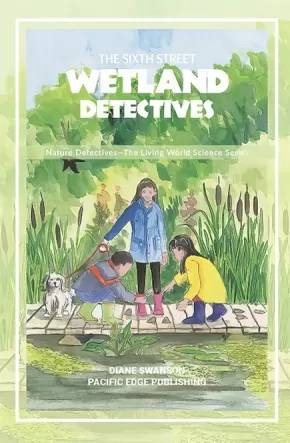The Sixth Street Wetland Detectives
Synopsis:
Join nature detectives Amy, Edward and Jill as they explore the wetlands near town. With their families, who are neighbours on Sixth Street, they make some exciting discoveries:
- Water lilies breathe through pores on the tops of their leaves.
- Duckweed is the world’s smallest flowering plant.
- Cattail colonies make good homes for many animals.
- Water striders walk across water.
- Muskrats build their houses from mud and stems.
The Sixth Street Wetland Detectives introduces readers to nature's wonderful wetlands. It shows how plants and animals interact and adapt to the wetland. It also teaches how living things depend on non-living things, such as water, light and soil.
The book also presents examples of wetland fossils, Indigenous peoples’ uses of wetlands and the ways people harm—and help—wetlands. By the end of the book, Amy, Edward and Jill want to help care for the wetland near their town. They find a way.
Series & Educator Information
The Nature Detectives Series is a set of five books. Each book introduces children to one of five fascinating ecosystems designed to address the grades 2 to 4 learning standards in the BC Science curriculum.
Each book introduces children to one of five fascinating ecosystems. The books show how plants and animals interact and adapt themselves to their environment. They show how living things depend on non-living things, such as water, light, and soil. The books also present examples of fossil life, Indigenous peoples’ uses of plants and animals in each ecosystem, and the ways people harm — and help — ecosystems. By the end of each book, readers will have a new appreciation for an important ecosystem.
Each text includes a glossary, index, and information about:
- the diversity of plants and animals in an ecosystem
- how plants and animals have adapted themselves to their environment
- how plants and animals interact with each other
- the life cycles of specific plants and animals
- fossil records of plants and animals
- the causes and effects of extinction and endangerment of plants and animals
- Indigenous peoples’ uses of plants and animals
Additional Information
46 pp. softcover, full-colour illustrations

 Go
Back
Go
Back




